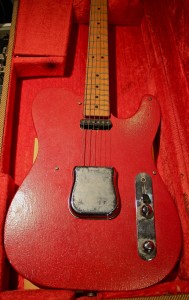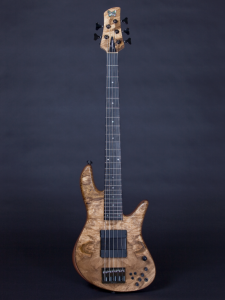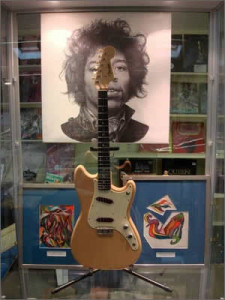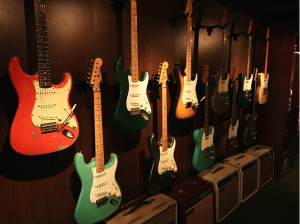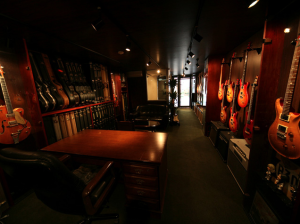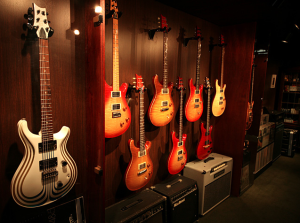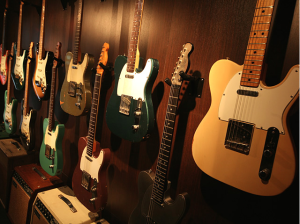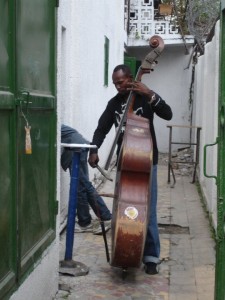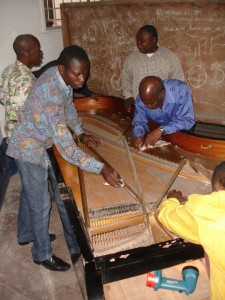Our Friend, Roger Mayer, just sent me this amazing article. I remember having read parts of this before somewhere – but could never remember where. Big thanks to Roger!
Check out the übercool products from Roger Mayer on VintageandRare here:
Hope you enjoy the article.
Kind regards, Nicolai
Jimi Hendrix: ‘You never told me he was that good’
On the the 40th anniversary of the great guitarist’s death, Ed Vulliamy speaks to the people who knew him best and unearths a funny, if driven, superstar.
Ed Vulliamy
The Observer, Sunday 8 August 2010
On the morning of 21 September 1966, a Pan Am airliner from New York landed at Heathrow, carrying among its passengers a black American musician from a poor home.
Barely known in his own country and a complete stranger to England, he had just flown first class for the first time in his life. His name was James Marshall Hendrix.
On 18 September 1970, four years later, I picked up a copy of London’s Evening Standard on my way home from school, something I never usually did. There was a story of extreme urgency on the front page and a picture of Hendrix playing at a concert – still ringing in my ears – at the Isle of Wight festival, only 18 days earlier. The text reported how Hendrix had died that morning in a hotel in the street, Lansdowne Crescent in Notting Hill, in which I had been born, and a block away from where I now lived.
During those three years and 362 days living in London, Hendrix had conjured – with his vision and sense of sound, his personality and genius – the most extraordinary guitar music ever played, the most remarkable sound-scape ever created; of that there is little argument. Opinion varies only over the effect his music has on people: elation, fear, sexual stimulation, sublimation, disgust – all or none of these – but always drop-jawed amazement.
The 40th anniversary of Hendrix’s death next month will be marked by the opening of an exhibition of curios and memorabilia at the only place he ever called home – a flat diagonally above that once occupied by the composer George Frideric Handel, on Brook Street in central London, in the double building now known as Handel House. The flat will be opened to the public for 12 days in September and there is talk about plans for a joint museum, adding Hendrix’s presence to that already established in the museum devoted to Handel. Involved in the discussions is the woman with whom Hendrix furnished the top flat of 23 Brook St, and with whom he lived: the only woman he ever really loved, Kathy Etchingham.
In a rare interview by telephone, (she has moved abroad), Ms Etchingham explains: “I want him to be remembered for what he was – not this tragic figure he has been turned into by nit-pickers and people who used to stalk us and collect photographs and ‘evidence’ of what we were doing on a certain day. He could be grumpy, and he could be terrible in the studio, getting exactly what he wanted – but he was fun, he was charming.
I want people to remember the man I knew.” When she met Hendrix (the same night he landed in London), he had already lived an interesting, if frustrating, 23 years. He was born to a father who cared, but not greatly, and a mother he barely knew – she died when he was 15 – but adored (she’s said to be the focus of two of his three great ballads, “Little Wing” and “Angel”). He had always been enthralled by guitar playing – a “natural”,immersed in R&B on the radio and the music of blues giants Albert King and Muddy Waters. When he was 18, he was offered the chance to avoid jail for a minor misdemeanour by joining the army, which he did, training for the 101st Airborne Division.
His military career was marked by friendship with a bass player called Billy Cox from West Virginia, with whom he would play his last concerts, and a report which read: “Individual is unable to conform to military rules and regulations. Misses bed check: sleeps while supposed to be working: unsatisfactory duty performance.”
Hendrix engineered his discharge in time to avoid being mobilised to Vietnam and worked hard as a backing guitarist for Little Richard, Curtis Knight, the Isley Brothers and others. But, arriving in New York to try and establish himself in his own right, Hendrix found he did not fit. The writer Paul Gilroy, in his recent book Darker Than Blue, makes the point that Hendrix’s life and music were propelled by two important factors: his being an “ex-paratrooper who gradually became an advocate of peace” and his “transgressions of redundant musical and racial rules”.
Hendrix didn’t fit because he wasn’t black enough for Harlem, nor white enough for Greenwich Village. His music was closer to the blues than any other genre; the Delta and Chicago blues which had captivated a generation of musicians, not so much in the US as in London, musicians such as John Mayall and Alexis Korner, and thereafter Eric Clapton, Peter Green, Jeff Beck and Jimmy Page among many others.
As luck would have it, the Brits were in town and Linda Keith, girlfriend of the Stones’ Keith Richards, persuaded Chas Chandler, bass player of the Animals, to go and listen to Hendrix play at the Cafe Wha? club in the Village. Chandler wanted to move into management and happened to be fixated by a song, “Hey Joe”, by Tim Rose. “It was a song Chas knew would be a hit if only he could find the right person to play it,” says Keith Altham, then of the New Musical Express, who would later become a kind of embedded reporter with the Hendrix London entourage. “There he was, this incredible man, playing a wild version of that very song. It was like an epiphany for Chas – it was meant to be.”
“To be honest,” remembers Tappy Wright, the Animals’ roadie who came to Cafe Wha? with Chandler that night, “I wasn’t too impressed at first, but when he started playing with his teeth, and behind his head, it was obvious that here was someone different.” Before long, Hendrix was aboard the plane to London with Chandler and the Animals’ manager, Michael Jeffery, to be met by Tony Garland, who would end up being general factotum for Hendrix’s management company, Anim. “When he arrived,” recalls Garland now, sitting on his barge beside the canal in Maida Vale, west London, where he now lives, “I filled out the customs form. We couldn’t say he’d come to work because he didn’t have a permit, so I told them he was a famous American star coming to collect his royalties.”
It is strange, tracking down Hendrix’s inner circle in London. His own musicians in his great band, the Experience – Noel Redding and Mitch Mitchell – are dead. Likewise, his two managers, Chandler and Jeffery, and one of his closest musician friends, the Rolling Stone Brian Jones; the other, Eric Burdon of the Animals, declined to be interviewed. But some members of the close-knit entourage are still around, such as Kathy Etchingham and Keith Altham, wearing a flaming orange jacket befitting the time of which he agrees to speak, in defiance of a heart attack only a few days before.
Music in London had reached a tumultuously creative moment when Hendrix arrived and was perfectly poised to receive him. “The performers were just your mates who played guitars,” recalls Altham. “It was tight – everyone knew everyone else. It was just Pete from the Who, Eric of Cream, or Brian and Mick of the Stones, all going to each other’s gigs.”
For reasons never quite explained, the blues – both in their acoustic Delta form, and Chicago blues plugged into an amplifier – had captivated this generation of English musicians more deeply than their American counterparts. Elderly blues musicians found themselves, to their amazement, courted for concerts, such as an unforgettable night at Hammersmith with Son House and Bukka White. Champion Jack Dupree married and settled in Yorkshire. “People [here] felt a certain affinity with the blues, music which added a bit of colour to grey life,” Altham continues. And as Garland points out: “White America was listening to Doris Day – black American music got nowhere near white AM radio. Jimi was too white for black radio. Here, there were a lot of white guys listening to blues from America and wanting to sound like their heroes.”
Things happened at speed after Hendrix landed. “‘Come down to the Scotch,’ Chas told me the day Jimi arrived and hear what I found in New York,” recalls Altham. “Jimi couldn’t play because he had no work permit, but he jammed that night, and my first impression was that he’d make a great jazz musician.” That was the night, his first in London, that Hendrix met Kathy Etchingham. “It happened straightaway,” she recalls. “Here was this man: different, funny, coy – even about his own playing.” “A short while later,” recalls Altham, “Chas took me to hear him at the Bag O’Nails club [in Soho] for one of his first proper gigs, turned to me and said, ‘What’ya think?’ I said I’d never heard anything like it in all my life.” At a concert in the same series, remembers Garland, “Michael Jeffery put an arm round Chas, another round me and said, ‘I think we’ve cracked it, mate.’” They had: Kit Lambert, according to Altham, literally scrambled across the tables to Chas at one of the shows and said, “in his plummy accent”, he had to sign him. Chas needed a record contract, Decca had turned Hendrix down (along with the Beatles) and Lambert was about to launch a new label, Track Records, with interest from Polydor: “The deal was done, on the back of a napkin,” says Altham.
Hendrix had formed his band at speed: a rhythm guitarist from Kent called Noel Redding – who had applied to join the Animals but to whom Hendrix now allocated bass guitar – and Mitch Mitchell, a jazz drummer seeking to mould himself in the style of John Coltrane’s great percussionist, Elvin Jones. With a stroke of genius, Jeffery came up with the only name befitting what was to follow: the Jimi Hendrix Experience. Is there any line in rock’n’roll more assuredly seductive as: “Are you experienced?/ Have you ever been experienced?/ Well, I have” (from 1967′s “Are You Experienced”)?
Paul McCartney, John Lennon and the other Beatles quickly converged to hear this phenomenon, along with the Stones and Pete Townshend. Arriving one night at the Bag O’Nails, Altham met Brian Jones “walking back up the stairs with tears in his eyes. I said, ‘Brian, what is it?’ and he replied, ‘It’s what he does, it chokes me’ – only he put it better than that”.
There was also curiosity from the emergent powerhouse of British blues: Cream and Eric Clapton. There was a particular night when Cream allowed Jimi to join them for a jam at the Regent Street Polytechnic in central London. Meeting Clapton had been among the enticements Chandler had used to lure Hendrix to Britain: “Hendrix blew into a version of [Howlin’ Wolf’s] ‘Killing Floor’,” recalls Garland, “and plays it at breakneck tempo, just like that – it stopped you in your tracks.” Altham recalls Chandler going backstage after Clapton left in the middle of the song “which he had yet to master himself”; Clapton was furiously puffing on a cigarette and telling Chas: “You never told me he was that fucking good.”
With a reputation, a recording contract and the adoration of his peers, Hendrix was allocated a flat belonging to Ringo Starr, in Montagu Square, in which he lived with Etchingham, Chandler and Chandler’s Swedish girlfriend, Lotta. It was not ideal, but base camp for an initial tour – as opening act for Cat Stevens and Engelbert Humperdinck, with the Walker Brothers topping the bill. Something was needed, Chandler thought, whereby Hendrix could blow the successive acts off the stage and Altham had the beginning of an idea. He said: “‘It’s a pity that you can’t set fire to your guitar.’ There was a pregnant pause in the dressing room, after which Chas said, ‘Go out and get some lighter fuel.’” Garland remembers: “I went out into Seven Sisters Road [in north London] to buy lighter fluid. At first, it didn’t make sense to me – there were too many things going on to worry about lighter fluid – but it all became clear in the end.”
Altham borrowed a lighter from Gary – the third Walker brother and drummer – and that night, at the Astoria theatre in central London, Hendrix set his guitar ablaze for the first time. “One of the security guards said, ‘Why are you waving it around your head?’” recalls Altham. “‘Cause I’m trying to put it out,’ replied Jimi. Actually, he only did it three times after,” says Altham, “but it became a trademark.”
The touring began in earnest during that winter of 1966-7: around working men’s clubs and little theatres in the north of England. “That’s when I remember him at his very best,” recalls Etchingham. “And at his happiest. The small clubs in regional venues. When he was desperate to make a name for himself, but was also playing for himself. In the working men’s clubs, they just wanted some music to enjoy while they drank their beer. In the small theatres, people had come to hear him. But that was his best music ever – played for its own sake. None of these crazy expectations, no one hanging on – just the people he knew, liked and trusted, and his own music.”
But what was this music, this singular, uplifting, otherworldly, menacing, exotic and erotic sound? “Hendrix was a magpie,” says Altham. “He would take from blues, jazz – only Coltrane could play in that way – and Dylan was the greatest influence. But he’d listen to Mozart, he’d read sci-fi and Asimov and it would all go through his head and come out as Jimi Hendrix. Then there was just the dexterity – he was left-handed, but I remember people throwing him a right-handed guitar and Hendrix picking it up and playing it upside down.” “And don’t forget,” says Tappy Wright, who acted as roadie at first, then joined the management team, “we were using the cheapest guitars. These were no Fenders or Stratocasters. These were Hofners we bought for a few quid. Very basic, but stretched to the fucking limit.”
The most precious insight comes from Etchingham. “People often saw Jimi on stage looking incredibly intense and serious. And suddenly this smile would come across his face, almost a laugh, for no apparent reason,” she says. “Well, I remember that very well, sitting on the bed or the floor at home in Brook Street. Sometimes, he would play a riff for hours, until he had it just right. Then this great smile would creep across his face or he’d throw his head back and laugh. Those were the moments he had got it right for himself, not for anyone else.”
Touring ran concurrent with work in the studio – first the singles: “Hey Joe”, the inimitable “Purple Haze” and “The Wind Cries Mary”, written for Kathy when Hendrix was left alone at home after she had stormed out from an argument, so the story goes (Mary is her middle name). “I never realised quite how hard he worked,” says Sarah Bardwell, director of the Handel House Museum, researching her new charge. The Experience would finish a concert up north, drive south, record between 3am and 9am, then return north for two more shows each day. LSD had yet to play a major role – if the Experience were on amphetamines, it was to keep the schedule.
In various studios, ending up at west London’s Olympic, work began. “I used to ring them up to book time,” recalls Etchingham. “Thirty quid an hour and they’d want the cheque there and then.” Chandler was aware of this and would occasionally hasten things along by taking what the band thought was a warm-up to be the finished product.
“‘What?’ the band would say,” recalls Altham. “‘That’s it,’ Chas would reply. ‘Now for the next one.’” But the soundscape unique to Hendrix, pushing the technology to its limits, was not serendipity, nor was it only about Hendrix’s genius: there was science behind the subliminal magic. “This was not ‘psychcolergic’, as Eric Burdon used to call it,” says Garland. “Hendrix knew exactly what he was doing.” And this process began with a man called Roger Mayer.
“We call this the Surrey blues Delta,” says Mayer, with a wave of his arms across the crazy-paving pathways of Worcester Park, near Surbiton. “Eric over here, Keith down the road, the Stones from there.” Mayer was an acoustician and sonic wave engineer for the Admiralty, a civil servant in the Ministry of Defence, but also an inventor of various electronic musical devices, including an improved wah-wah pedal and the “Octavia” guitar effect with its unique “doubling” effect. “I’d shown it to Jimmy Page, but he thought it was too far out. Jimi said, the moment we met, ‘Yeah, I’d like to try that stuff.’” “One of my favourite memories of all,” says Etchingham, “is Jimi and Roger huddled together over the console and the instruments, talking about stuff way over my head, and then this glorious thing happening.”
“We started from the premise that music was a mission, not a competition,” says Mayer, who describes himself as a “sonic consultant” to Hendrix. “That the basis was the blues, but that the framework of the blues was too tight. We’d talk first about what he wanted the emotion of the song to be. What’s the vision? He would talk in colours and my job was to give him the electronic palette which would engineer those colours so he could paint the canvas.
“Let me try to explain why it sounds like it does: when you listen to Hendrix, you are listening to music in its pure form,” he adds. “The electronics we used were ‘feed forward’, which means that the input from the player projects forward – the equivalent of electronic shadow dancing – so that what happens derives from the original sound and modifies what is being played. But nothing can be predictive – it is speed-forward analogue, a non-repetitive wave form, and that is the definition of pure music and therefore the diametric opposite of digital. “Look, if you throw a pebble into a lake, you have no way of predicting the ripples – it depends on how you throw the stone, or the wind. Digital makes the false presumption that you can predict those ripples, but Jimi and I were always looking for the warning signs. The brain knows when it hears repetition that this is no longer music and what you hear when you listen to Hendrix is pure music. It took discussion and experiment, and some frustrations, but then that moment would come, we’d put the headphones down and say, ‘Got it. That’s the one.’ “But I take none of the credit,” insists Mayer. “You can build a racing car just like the one that won the 1955 grand prix. But if you can’t drive like Juan Manuel Fangio, you’re not going to win the grand prix. Jimi Hendrix only sounds like he does because he was Jimi Hendrix.”
Everyone knows that Hendrix had hundreds of women, often concurrently – but that is not as interesting as the fact that, says Altham, “Kathy Etchingham was the love of his life”. Mayer recalls them “oozing affection, even when there was a row – he needed her very badly indeed”. Hendrix called the flat into which he moved with her in 1968 “the only home I ever had”.
“We knew we wanted Mayfair,” says Etchingham, “so we could walk to the gigs, but the prices were high, even though it was a little seedy – £30 a week.” The couple furnished the split-level, top-floor apartment together with prints and wall hangings from Portobello Road. When Hendrix found out that Handel had lived downstairs, “he went round to HMV or One Stop Records to get Messiah,” says Sarah Bardwell. “What is so interesting is that they were both musicians from abroad, who came to London to make their name in this building.”
It feels extraordinary now to walk over the venerable floorboards past a replica of Handel’s harpsichord, portraits of the composer and the score of Messiah in the room in which it was composed, then up a wooden staircase to Hendrix’s whitewashed sitting room and bedroom above. Sarah Bardwell’s aim is for a joint Handel-Hendrix house museum of some kind. Blue English Heritage plaques accompany each other on the wall outside; Hendrix was added in 1997, a labour of devotion by Kathy Etchingham, who recalls English Heritage balking at the fact that the shop front below was a lingerie shop, “all mannequins wearing suspenders and knickers”, which needed covering up while the plaque was unveiled.
Now, it is the posh Jo Malone perfumery, though “in our day it was Mr Love’s cafe,” she recalls fondly. “On the corner of Oxford Street. And there was an Indian tea shop we’d go to in South Molton Street, and always HMV or One Stop – and we’d walk to the gigs along Regent Street or across Hanover Square, and maybe take a taxi home.”
The memories of the people who actually knew him overshadow the tragic, antiheroic Hendrix of popular imagination. Etchingham and Keith Altham recall a man with a sense of humour. “If things were getting tense in the studio,” says Altham, “he’d just play ‘Teddy Bears’ Picnic’.” Adds Tony Garland: “If I told Jimi to ‘kiss my arse’, he’d answer, ‘You’ve got a rubber neck, do it yourself’ with a sly grin. You always knew you were with someone quicker-witted than yourself.”
Altham also talks about Hendrix “saying nothing to reporters, or contradictory things, on purpose. He would pat his fingers against his lips mid-sentence and go, ‘etcetera, etcetera, etcetera’, in order to say, in effect, nothing. He wanted the music to speak. He also had this way of saying things that made you do a double take: ‘Did he really say that?’ Such as, just before he went on to play with Clapton, who was his idol, for the first time, he told me, ‘I want to see if he is as good as he thinks I am’ – which is not at all the remark you first think it is.”
But many of those who comprised Hendrix’s inner circle in London now talk about some demise in his mental agility once he became popular in his native US, a mass commodity caught between the triangle of his own “racially transgressive” music, his blackness and the black power movement, and his overwhelmingly white audience. Even then, though, Hendrix closed the 1969 Woodstock festival with a version of “The Star-Spangled Banner”, which became the anthem for both the movement against the war in Vietnam and Hendrix’s own complicated empathy with the young American fodder sent to fight it, as a former military man himself. Many of his childhood friends were over there, some never to return. The anthem made Jimi famous worldwide, veering into a vortex out of which emerged “Purple Haze”, a glorious, lyrical dirge – for something, for everything; an endpiece not only to Woodstock but to so many dreams.
“Chas Chandler would come into the studio and find two women in his chair,” recalls Tappy Wright. “‘Get out of my chair!’ he’d say. And then, well, there were drugs, drugs, drugs. I never took any, because I had to make sure everyone got out of bed in the morning – but they were around, too much around.” Altham says that Chandler told him “that he gave Jimi an ultimatum: ‘Either I go or the hangers-on go.’ But there was no getting rid of them, so Chas quit and Jimi was left with Michael Jeffery”.
“Jimi was at his best when the fame never got in the way of the music,” says Etchingham, “and at his worst when the fame took over, when people who hardly knew him suddenly became his best friends.” “He had this thing,” says Altham, “of not being able to say no to people – and this became a problem.”
Even the flat on Brook Street became an open house, to journalists, anyone. “It’s funny,” says Sarah Bardwell. “Here we are trying to contact his old friends who are now superstars for our events and exhibition, and it’s like laying siege to Fort Knox! Yet Hendrix was available to anyone, perhaps almost too much so.”
Despite the distractions, there was one project consistently dear to Hendrix’s heart: the state-of-the-art Electric Lady Studios in New York, opened with a party on 26 August 1970, the night before he was due to fly back to England to play the Isle of Wight festival. Only Hendrix was almost too shy to appear and, when he did so, he retreated to the steps outside, where he met a young singer-songwriter too shy to enter the fray – Patti Smith. “It was all too much for me. Johnny Winter in there and all,” recalled Smith in a past interview with the Observer. “So I thought, ‘I’ll just sit awhile on the steps’ and out came Jimi and sat next to me. And he was so full of ideas; the different sounds he was going to create in this studio, wider landscapes, experiments with musicians and new soundscapes. All he had to do was get over back to England, play the festival and get back to work…”
It had been a long weekend on the Isle of Wight and, for me, an exciting one. I was compelled – not disgusted, as is the official history – by the determination of French and German anarchists to tear down the fences so that it be a free festival. I loved the fact that Notting Hill’s local band, Hawkwind, played outside the fence in protest at the ticket prices. The strange atmosphere added to the climactic moment, after the Who and others: the one set, at 2am on the Monday, for which it was imperative to get down from among the crowds on Desolation Row and force a way right to the front and concentrate or, rather, submit to hypnosis. The set by Jimi Hendrix.
It is written in the lore of Hendrixology that this was a terrible performance. Hendrix had arrived exhausted, by the previous month’s events, the upcoming tour, the day’s violence and by walkie-talkie voices that somehow made their way into the PA system. But all I remember, having just turned 16, is a dream coming true: the greatest rock musician of all time (one knew this with assurance) dressed in blazing red and purple silks, actually playing the version of “Sgt Pepper’s” about which I had read so much in NME, playing “Purple Haze”, “Voodoo Chile” and a long, searing “Machine Gun”, just yards away. I remember the sound – the sounds, plural – bombarding me from the far side of some emotional, existential, hallucinogenic and sexual checkpoint along the road towards the rest of my life. I remember him playing the horn parts to “Sgt Pepper’s” on his guitar! I remember the deafening and painful silence after he finished his fusillade and in the crowd a mixture of rapture, gratitude, enlightenment and affection.
Afterwards, Hendrix went on a reportedly disastrous tour of Scandinavia and Germany (failing to meet one of his two children, by a Swedish girlfriend – the other he had sired in New York and also never met), before returning to the Cumberland hotel and the room in which he gave his last ever interview, to Keith Altham. (To mark the anniversary, the Cumberland has designed and decorated these rooms in a swirl of colour, stocked it with Hendrix music and called it the Hendrix Suite, in which people can stay.)
“There were two women in the room,” recalls Altham. “One of them was a girlfriend called Devon Wilson and she was dodgy – she dealt him drugs and I can say that now because she’s dead. But he knew me well by this time and he seemed better than I’d seen him previously.” The interview is a remarkable one, utterly devoid of all the nonsense that would ensue about suicide and a death wish. On the tape, Hendrix laughs and jokes; he tells Altham about plans to re-form the Experience and tour England again.
On the night of 16 September, Hendrix went to Ronnie Scott’s without his guitar, hoping to jam with Eric Burdon’s new band, War. Burdon considered him unfit to play. The following night, he returned and joined his friend on stage. “I was tired, I missed it,” says Altham, “though, of course, I regret that now. It was the last time Hendrix ever played the guitar.”
Hendrix went on to a party with a German woman, Monika Danneman, and back to her rooms at the Samarkand hotel in Lansdowne Crescent. There are so many accounts of exactly what happened next, but all converge on the fact that he had drunk a fair amount, taken some kind of amphetamines (“Black bombers, I think, given to him by Devon Wilson,” surmises Altham) and some of Danneman’s Vesparax sleeping pills, not knowing their strength. He vomited during the deep ensuing sleep, insufficiently conscious enough to throw up; Danneman panicked, and telephoned Burdon, who urged her to call an ambulance. But the greatest guitarist of all time was dead upon arrival at St Mary Abbot’s hospital, aged 27. (Sadly, Danneman took her own life in 1996.)
So it was, back in September 1970, that I made my way up Lansdowne Rise and round the corner to the Samarkand hotel after reading the news today, oh boy. I was amazed to have the pavement outside the address at which Jimi Hendrix had died that morning all to myself for a good couple of hours – not a soul. I went home, got some chalk, and wrote: “Scuse us while we kiss the sky, Jimi” on the flagstones (OK, but I was only 16) and retreated to watch. Nothing happened and after another hour, a man came out and washed the words away and I returned home to write a lament in my diary, which I still have, the Standard’s front page folded at the date.
Speculations about suicide and murder are too ridiculous to contemplate – most of them are probably concocted in order to dramatise and distract from the awful reality of such a genius dying in this way – but what does matter are Kathy Etchingham’s reflections.
“Jimi died because the simple things got complicated. He was born to a father who was an alcoholic and a mother who died and he died because he was in that flat in Notting Hill with a complete stranger who gave him a load of sleeping pills without telling him how strong they were. It’s as simple and as complicated as that.
“I’m older and wiser now,” she says. “I enjoy culture and the fine things in life. I can look back and see all that more clearly than I did at the time – I was so young, only 24.” Of the compelling memoir she has written, Through Gypsy Eyes, she says: “I’d like to go over it again, fill in a few things, but what I want now, most of all from this anniversary, is for people to understand that it was in Britain that he was welcomed, it was there he was happy and such fun to be around – yes, grumpy at times, and a handful – but such a man. I’d like the young people to know that.”
“Let’s face it,” says Tappy Wright, “if Jimi had stayed with Kathy, he’d probably be alive and playing still. Plus, he always said he wanted to be buried in London, not Seattle, where he was born and his family lived. It wasn’t just me he told that, it was plenty of people – that this was home.” “Still,” says Etchingham, “at least we’ve got the plaque, the Handel House Museum, and I’m looking forward to seeing everyone in September.
They were great times and we’ll take a trip down memory lane. Only 40 years is a long time and Jimi won’t be there.”
http://vintageandrare.com/roger-mayer

